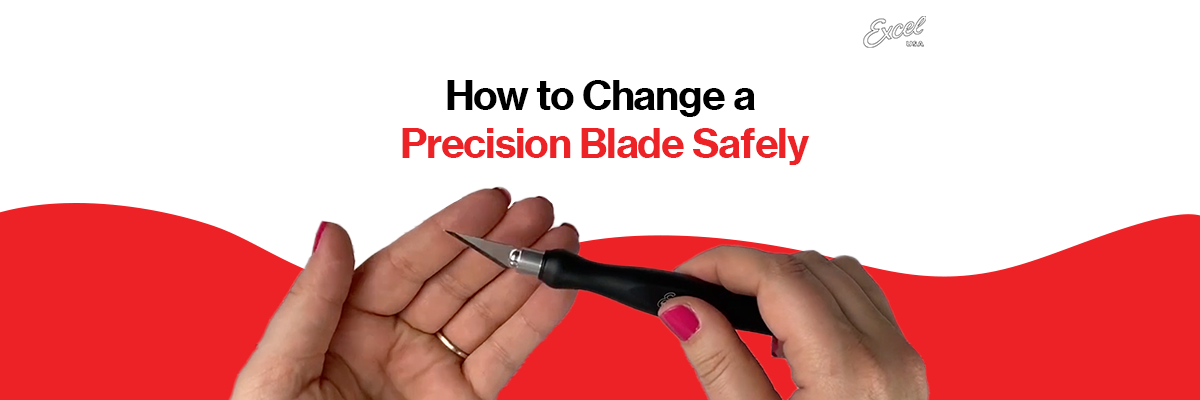
How to Safely Change the Blade on a Craft Knife (w/ Infographic)
Precision knives are the workhorses of crafting, hobby modeling, graphic design, and DIY projects. But even the sharpest blade dulls over time. Whether you use an Excel Blades K1, K5, or any standard craft knife, knowing how to change a precision blade safely is essential to prevent injury, improve accuracy, and extend the lifespan of your tool.
In this in-depth guide, we’ll walk you through everything you need to know—from identifying when to replace your blade to the safest way to do it. Plus, download our free infographic for easy reference at your workstation.
Why Changing a Dull Blade Is Non-Negotiable
A dull blade does more than ruin your project—it puts your safety at risk. Here's why you should never delay a blade change:
- Dull blades require more pressure, increasing the chance of slipping
- They cause tearing, uneven cuts, and frayed edges
- Risk of accidental injury rises with blade force
Also Read: Explore different types of precision blades and their uses
Tools You’ll Need to Change a Precision Blade
To change your blade safely and efficiently, gather these items:
- New blade (always use manufacturer-recommended replacements)
- Your craft knife handle (K1, K5, or similar)
- Pliers or a blade-changing tool (optional, for safety)
- Safety gloves (especially if you're a beginner)
- A self-healing cutting mat (to prevent slips)

Step-by-Step: How to Change a Precision Blade
Here's a comprehensive craft knife blade changing guide you can follow:
Step 1: Choose a Clean, Stable Work Surface
Use a self-healing cutting mat or a stable tabletop. Avoid working over carpet or cluttered areas.
Step 2: Put on Safety Gloves (Optional but Recommended)
Lightweight cut-resistant gloves can help protect your fingers.
Step 3: Loosen the Blade Chuck or Collar
For Basic K1 Craft Knives and most hobby knives:
- Twist the knurled metal collar near the blade counterclockwise
- This loosens the internal chuck that holds the blade
Safety Tip: Keep your fingers away from the blade’s sharp edge at all times.
Step 4: Carefully Remove the Old Blade
Use tweezers or needle-nose pliers to gently pull the blade out of the slot. If you're planning to pull the blade with your fingers, proceed with caution and wear your gloves at all times. Pull the blade in an outward motion, away from your body.
Step 5: Insert the New Blade
Hold the new blade by the blunt edge. Slide it into the same slot where the old blade was. Twist the metal collar back and ensure it fits snugly and straight.
Step 6: Tighten the Chuck Securely
Twist the collar clockwise to lock the blade in place. Test it gently on a scrap surface to confirm it's secure.
Blade Changing Safety Tips (From the Pros)
- Always change blades when you feel resistance or see ragged cuts
- Store used blades in a designated blade disposal container
- Never force a blade in or out of the handle
- Do not attempt to bend or modify blades
- Avoid distractions while changing blades
Read: How to dispose of used hobby blades safely — Recycle Nation
Downloadable Infographic: Changing a Precision Blade Safely
Want a visual reference? Download and print this step-by-step infographic to keep at your workspace.
Download PDF: How to Change a Precision Blade (Infographic)
Also Watch: Excel Blades - How to replace our #11 blade on our K1 knife
Common Blade Types & Compatible Handles
|
Blade Style |
Best For |
Compatible Handles |
|
General purpose, paper, vinyl |
K1, K2, K18 |
|
|
Sculpting, carving, fabric |
K1, K5 |
|
|
Wood, linoleum, scoring |
K26, K6 |
|
| #92 Utility Blade | Scoring, drywall cutting |
Folding utility knives |
See our Full Guide to Blade Shapes and Uses
When Should You Replace Your Blade?
How long does a precision blade last? What are the signs a blade is dull?
- After 1-2 hours of heavy use (e.g., thick paper, cardboard)
- When you notice fraying, skipping, or jagged cuts
- If your project requires increased cutting pressure
- After a drop or tip bend
Tip: Always keep extra blades on hand to avoid delays mid-project.
Recommended Products for Safe Blade Changing
- Excel Blades K1 Knife with #11 Blades – Check Knives & Cutters Collection
- Self-Healing Cutting Mats (A4 or A3) – View Cutting Mats Collection
- Knife Holder with Blade Dispenser – Shop safety accessories
Final Thoughts: Respect the Blade
Changing a craft knife blade might seem simple, but doing it improperly can lead to ruined projects or injury. Follow the steps, treat every blade like it’s razor-sharp (because it is), and prioritize safety every time.
Stay sharp. Stay safe.
You May Also Watch: How to Replace an Excel Blades K18 Knife